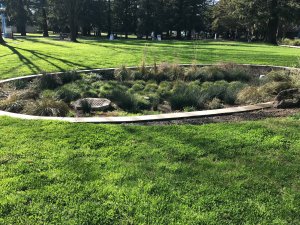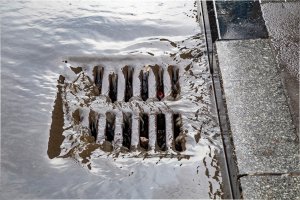Managing Spring Rain, Snowmelt, and Stormwater at Home
March 15, 2023
By: Erin Parker, Interpretive Services Supervisor
Water, water everywhere. With snow melting and rain falling, southeastern Michigan’s springs can arrive in a flood. Spring rains trigger amphibian mating seasons and give gardeners itchy fingers to get out and start growing, but all that water can cause big problems, too. There are a few things that homeowners can do to help ease the excess water on their own properties and contribute to cleaner, healthier waterways throughout the region.
On the lookout for hard surfaces
Looking around your property, school, or other site: how much of it is covered by hard surfaces? Hard surfaces, also called impervious surfaces, include roofs, paved parking lots and driveways, concrete sidewalks and patios. These surfaces are durable to keep water from seeping through them, but in times of heavy down pours or spring thaws, these allow water to move rapidly. While reducing the hard surfaces isn’t typically a feasible solution, there are options that can increase permeability of other sections of a property.
Following the flow of water after a heavy rain can help determine where lower places in the landscape already exist. If you can take advantage of a low spot where water already wants to move, reducing lawn and increasing wetland or rain garden plants instead can lessen the impacts of stormwater. Rain gardens consist of a variety of plants that thrive in fluctuating water conditions. During wet springs, they can absorb excess water and during hot, dry summers, these deep-rooted plants can continue to take in soil moisture that isn’t available to shallow-rooted lawn grasses. Plus, rain garden plants can feed wildlife, including pollinators, and add to the overall appeal of a yard through the addition of flowering plants. Rain gardens are not ponds, and are not intended for long-term water retention or long periods of standing water after a rain event. They are shallow areas that capitalize on the natural contours of a space during periods of heavy precipitation or rapid snow melt.

Along with rain gardens, increasing tree cover and non-lawn grasses, plants, and gardens can improve the permeability of a property. Lawn grass, while more permeable than cement and asphalt, doesn’t soak up or slow down water like broad leaved and deeper-rooted trees and plants do. Rain falling off a tree or shrub canopy is slowed down before it hits the ground, and instead of rushing over the short cut grass of a lawn, can sink into the soil.
Downspouts can be modified or moved to help facilitate water movement off of roofs and into rain gardens or rain barrels. A rain barrel is commonly used to collect precipitation during times of plenty and storing it for hot, dry summers when that same water becomes valuable to the plants in your yard or garden.
Storm drains to the rescue

Another simple thing that community members can do to enhance the flow of stormwater is to consider adopting a drain! Storm drains are one source of both problems and solutions when it comes to moving water. Drains help collect and move water off of roads and properties, but they need to be clear and clean in order to do this work. Anything that enters a storm drain, from spilled oil to plastic bags, will clog the drain and eventually end up in our local waterways. Keeping drains clear of organic matter like fallen leaves and litter means that water moves as intended and reduces negative impacts on our lakes and streams. Adopting a drain or two can help move water out of your local neighborhood while improving water quality in the region- it’s much easier to prevent things from entering our shared waterways in the first place than trying to remove it later.
Managing stormwater and reducing impacts to our water quality can require structural and regional changes, but simpler projects like building rain gardens, reducing hard surfaces, and keeping our storm drains clear can make a big impact, too.
Resources:
